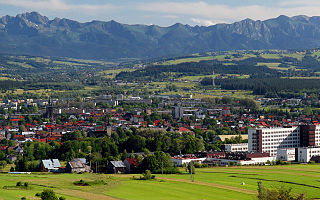
The House of Romanov was the reigning royal house of Russia from 1613 to 1917.

A saltire, also called Saint Andrew's Cross or the crux decussata, is a heraldic symbol in the form of a diagonal cross, like the shape of the letter X in Roman type. The word comes from the Middle French sautoir, Middle Latin saltatoria ("stirrup").
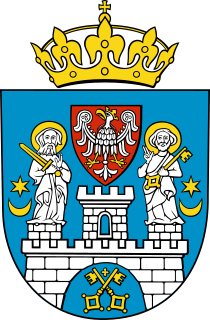
The coat of arms of Poznań consists of white city walls with three towers. On the left (heraldic) tower stands Saint Peter with a key and on the heraldic right one stands Saint Paul with a sword. In the gate there are two golden crossed keys with a cross above. Over the middle tower, which contains a single window and is topped by a battlement, there is a gothic shield with a white eagle in crown. On the sides of the two saints there are golden crescents and stars. All of those elements are on a blue field. Over the shield there is golden crown. Author of modern version of coat of arms is Jerzy Bąk.
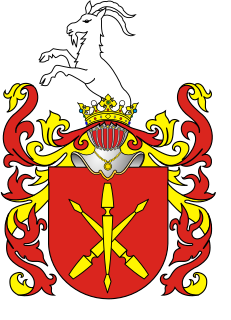
Tomasz Zamoyski was a Polish-Lithuanian nobleman (szlachcic) and magnate.

The Miraculous Medal, also known as the Medal of Our Lady of Graces, is a devotional medal, the design of which was originated by Saint Catherine Labouré following her apparitions of the Blessed Virgin Mary in Rue du Bac, Paris, France, and made by goldsmith Adrien Vachette.

The rose is a common device in heraldry. It is often used both as a charge on a coat of arms and by itself as an heraldic badge. The heraldic rose has a stylized form consisting of five symmetrical lobes, five barbs, and a circular seed. The rose is one of the most common plant symbols in heraldry, together with the lily, which also has a stylistic representation in the fleur-de-lis.
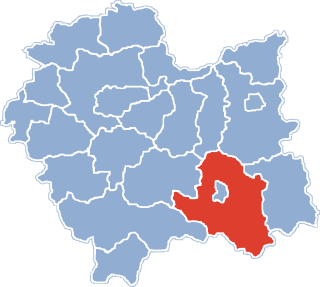
Nowy Sącz County is a unit of territorial administration and local government (powiat) in Lesser Poland Voivodeship, southern Poland, on the Slovak border. It came into being on January 1, 1999, as a result of the Polish local government reforms passed in 1998. Its administrative seat is the city of Nowy Sącz, although the city is not part of the county. The county contains five towns: Krynica-Zdrój, 31 km (19 mi) south-east of Nowy Sącz, Stary Sącz, 9 km (6 mi) south-west of Nowy Sącz, Grybów, 19 km (12 mi) east of Nowy Sącz, Piwniczna-Zdrój, 21 km (13 mi) south of Nowy Sącz, and Muszyna, 33 km (21 mi) south-east of Nowy Sącz.
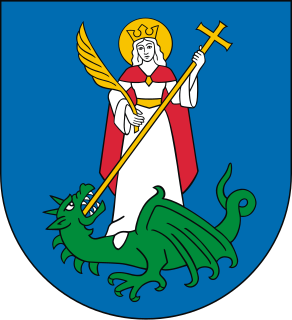
The coat of arms of Nowy Sącz in Poland shows Saint Margaret the Virgin, depicting the legend that she was swallowed by Satan, in the form of a dragon, who was however forced to spit her out again because the cross she was carrying irritated the dragon's innards. In Margaret's other hand is an olive branch, a symbol of peace.

Nowy Targ County is a unit of territorial administration and local government (powiat) in Lesser Poland Voivodeship, southern Poland, on the Slovak border. It came into being on January 1, 1999, as a result of the Polish local government reforms passed in 1998. Its administrative seat and largest town is Nowy Targ, which lies 67 kilometres (42 mi) south of the regional capital Kraków. The county also contains the towns of Rabka-Zdrój, lying 18 km (11 mi) north of Nowy Targ, and Szczawnica, 35 km (22 mi) east of Nowy Targ.

The flag of Saint Barthélemy is the French tricolor. This is because Saint Barthélemy is a self-governing overseas collectivity of France. An unofficial flag of Saint Barthélemy consisting of the island's coat of arms centered on a white field is also used on the island.
Gmina Nowy Targ is a rural gmina in Nowy Targ County, Lesser Poland Voivodeship, in southern Poland. Its seat is the town of Nowy Targ, although the town is not part of the territory of the gmina.
Gmina Raba Wyżna is a rural gmina in Nowy Targ County, Lesser Poland Voivodeship, in southern Poland. Its seat is the village of Raba Wyżna, which lies approximately 14 kilometres (9 mi) north-west of Nowy Targ and 55 km (34 mi) south of the regional capital Kraków.
Gmina Rabka-Zdrój is an urban-rural gmina in Nowy Targ County, Lesser Poland Voivodeship, in southern Poland. Its seat is the town of Rabka-Zdrój, which lies approximately 18 kilometres (11 mi) north of Nowy Targ and 50 km (31 mi) south of the regional capital Kraków.
Gmina Szaflary is a rural gmina in Nowy Targ County, Lesser Poland Voivodeship, in southern Poland. Its seat is the village of Szaflary, which lies approximately 4 kilometres (2 mi) south of Nowy Targ and 71 km (44 mi) south of the regional capital Kraków.

Attributed arms are Western European coats of arms given retrospectively to persons real or fictitious who died before the start of the age of heraldry in the latter half of the 12th century. Arms were assigned to the knights of the Round Table, and then to biblical figures, to Roman and Greek heroes, and to kings and popes who had not historically borne arms. Each author could attribute different arms for the same person, but the arms for major figures soon became fixed.

Tylicz is a village in the administrative district of Gmina Krynica-Zdrój, within Nowy Sącz County, Lesser Poland Voivodeship, in southern Poland, close to the border with Slovakia. It lies approximately 6 kilometres (4 mi) east of Krynica-Zdrój, 35 km (22 mi) south-east of Nowy Sącz, and 108 km (67 mi) south-east of the regional capital Kraków.

Pyzówka is a village in the administrative district of Gmina Nowy Targ, within Nowy Targ County, Lesser Poland Voivodeship, in southern Poland. It lies approximately 9 kilometres (6 mi) north-west of Nowy Targ and 59 km (37 mi) south of the regional capital Kraków.
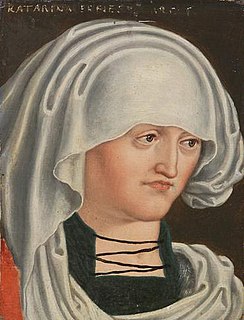
Catherine of Austria was a member of the House of Habsburg and through marriage Margravine of Baden.

Jadwiga Apostoł-Staniszewska was a Polish teacher in the interwar period, an underground activist during World War II, and a writer in postwar Poland.

